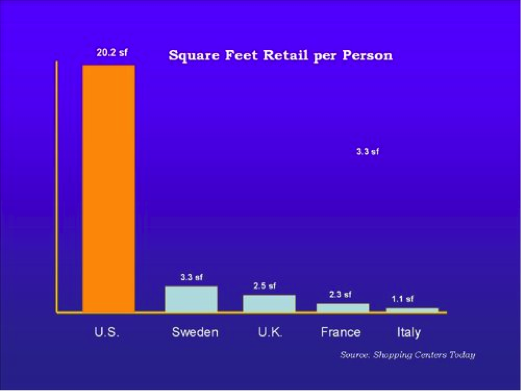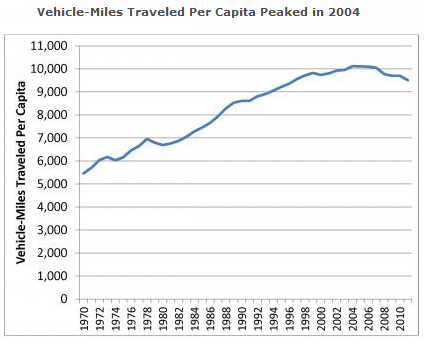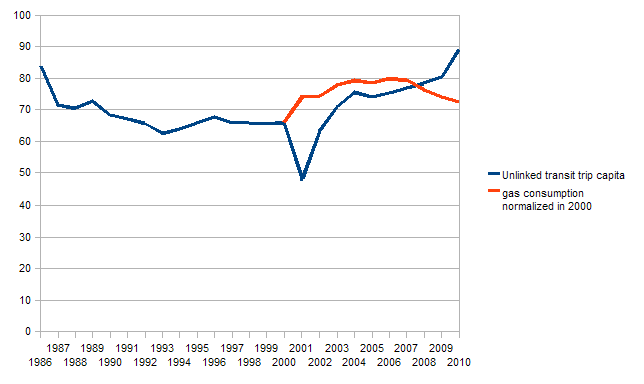HTMAPODWTTC 11: The Diminishing Returns of Suburbia
January 20, 2013
Recently, I’ve talked about the diminishing returns of Heroic Materialism.
December 4, 2011: The Diminishing Returns of Heroic Materialism 2: End of the Line
October 30, 2011: The Diminishing Returns of Heroic Materialism
Suburbia is certainly part of our Heroic Materialist modality. Like other Heroic Materialist patterns of behavior, what once produced stunning advances, and later produced steady benefits, it is now producing more problems and increasing difficulties.
Before, I talked in a more general sense. But, today I will talk in an actual financial sense, in terms of IRR, which is to say, the profit from capital invested in new suburban development.
August 22, 2010: How to Make a Pile of Dough with the Traditional City
Any business or investment trend tends to have a certain pattern. Warren Buffett called it: “Innovators, Imitators, and Idiots.”
At first come the Innovators. (I would say the Visionaries come earlier, but they usually aren’t businesspeople. The Innovators take the Visionaries’ ideas and turn them into profitable business ventures.)
June 6, 2010: Transitioning to the Traditional City 2: Pooh-poohing the Naysayers
May 23, 2010: Transitioning to the Traditional City
The characteristic of Innovation is potentially very high profits, but also high risk. You just don’t know what will happen. If you did, it wouldn’t be innovation. For example, the iPhone turned out to be a huge hit for Apple, with monster profit margins. However, it might have been a dud. It was certainly innovative, when it first came out.
As the Innovation becomes better understood, others attempt to capture some of those large profit margins. Capital flows into the sector, competition intensifies, and profit margins come down. The Imitators arrive, in large numbers. At first, the competition can be rather innovative too, but usually in terms of incremental improvements, not the clean-sheet-of-paper leaps of the Visionaries, turned into businesses by the first Innovators.
After a while, things become rather more commoditized. Incremental improvements are still happening, but they are small steps now. Returns on capital are falling to average historical levels, but the risk is fairly low because the patterns are well established.
Toward the end of the cycle, you get two things. The first wave of Imitators were fairly successful, and people say: “well, if that guy can do it, I can to.” You get successive stages of Imitators, each one typically less talented than the last. Eventually, you get a wave of Idiots — people who imitate the outward form of the Imitators, but often in a way that is almost certainly doomed to failure. The Idiots think the risk is low, because of the large number of successful Imitators preceding them, but actually the risk is rising because the market is becoming saturated, profits are disappearing, and the new wave of Idiots is not sensitive to risk. Too much capital is invested. Returns on capital fall below historical averages. At the end, there is typically a surge of Idiots, and a large amount of capital is invested in projects that have widespread losses — losses that, in hindsight at least, seem easily forseeable.
Today, we are talking about things from a developer’s perspective. This means the marginal addition to Suburban Hell, the next new building project, not what is already there. For the last ninety years or so — basically since the introduction of affordable automobiles like the Ford Model T in the 1920s — the basic pattern of Suburban Hell expansion has been:
1) Single family homes built on greenfield, further and further from city centers.
2) Larger and larger homes
3) Strip mall-type commercial/shopping areas to serve these homes (i.e. big parking lots)
4) Lots and lots of very wide streets to accommodate all the traffic implied by the above
5) Superhighways to make it easier to travel from these ever-more-distant greenfield developments to elsewhere in the city
March 7, 2010: Let’s Take a Trip to Suburban Hell
July 26, 2009: Let’s Take a Trip to an American Village 3: How the Suburbs Came to Be
July 19, 2009: Let’s Take a Trip to an American Village 2: Downtown
July 12, 2009: Let’s Take a Trip to an American Village
Not surprisingly, all of these patterns have reached something of a limit:
1) New developments are too far from anything, and often imply commute times of an hour or more each way
2) Homes are too large for people to afford
3) Waaaay too much strip-mall type development, plus the realization that it is horrifically ugly
4) Land use patterns that are dominated by Non-Place (parking lots, roadways, and “green space” to make it all a little less hideous), i.e. “sprawl”
October 10, 2009: Place and Non-Place
If these are the problems, the solutions might reasonably involve:
1) New developments that are closer to where people want to be (city centers, train stations, beaches and other natural amenities, and other centers of commerce or employment)
2) Smaller, more affordable homes
3) Much less strip mall development
4) Land use patterns that are dominated by Place — pleasant environments for people
September 20, 2009: The Problem of Scarcity 2: It’s All In Your Head
September 13, 2009: The Problem of Scarcity
Naturally, this fits right in with our Traditional City ideas. I won’t go on and on about that right now.
What I am hearing from developers today is that most of them plan to sell to the “high end,” that is, high income or genuinely wealthy people. Why? Because these are the only ones that can you can still sell the existing pattern of Suburban Hell development to. They can afford to live in high-value areas, with shorter travel times etc., they can afford the two cars necessary to live in Suburban Hell, they can afford the high taxes necessary to pay for all the public infrastructure (immense roadways) of Suburban Hell, and they can afford the larger houses that developers want to build (because that is what they have been doing for their entire career), and still have enough of a profit margin to justify doing so.
You can’t really sell a lower-priced house at all these days, because they were so overbuilt in the 2000-2005 era that they are now selling for well under construction cost. Obviously, you can’t compete with that, which is why overall housing starts are very low. This is capitalism’s way of telling you to stop building houses.
However, eventually that excess supply will be absorbed somehow. Some of it will simply be abandoned and bulldozed. Even at a price of near-zero, it is in a location that is not worth occupying. This is the case in Detroit, but also in the farthest-flung outskirts of the California suburbs. Over time, the houses will be abandoned and deteriorate, and not be worth the money to renovate and repair. Also, they will be occupied by the sort of unpleasant people and activities (squatters/welfare cases/meth labs) that nobody wants to live around. The kind of people that might be interested in a cheap house will find that they can’t afford to commute from these locations, and there aren’t enough jobs locally. Thus, whether an old city like Detroit or a development built in 2004 in the California desert, the housing stock will simply disappear.
In those more attractive areas, like a condo in central Miami or San Diego, eventually the excess supply will be absorbed by people moving in.
After the excess supply is eliminated or absorbed, then comes the question of what should be built next. What I think developers will find is that it is simply no longer practical (i.e. profitable) to expand further outward into new greenfield development. Also, houses will become smaller — a lot smaller. I think they will go back to a 1950s standard of about 1000sf, as an average for new residential development.
Both of these are related to cost, and also benefits. These distant greenfield developments are not particularly pleasant places, so the only way to get people to live there is to have a low price, which also means a low profit margin, or perhaps no profit. Also, the further away you are, the more you have to drive, which is also quite expensive.
Developers are genuinely not evil people. If the profit is there, they will build whatever you like. Also, developers are, for the most part, an imaginative and flexible bunch. They are inherently creators, and thus, in a sense, creative people, open to new ideas. Every new construction development begins as a new idea, a business dream, so this is something they are very accustomed to. Much of the problem lies with the people that developers work with, such as architects and planners (i.e., architects who help build whole developments, not just a single building), municipal bureaucrats (“urban planners”), banks (very risk-averse, and who favor tried-and-true), other investors and so forth.
We are now in a period of “debt supercycle” credit contraction, in my view. At least, the private economy is, while governments are in their own phase of debt self-destruction. This period could last a long time.
What this means in a practical sense is that potential purchasers of new property will be fairly conservative regarding the ratio of purchase price to income. The notion of “three times income” for a house is considered “conservative” today, but that is actually an estimate of the most you can borrow, while having a fair chance of actually paying off the debt. That is, actually, the redline for family finances. There’s nothing conservative about it, it is pushing things to the limit. So, we should be thinking more like about 2x annual income. (I previously suggested 1x income, but realistically Americans will still buy as much house as they can get away with.) With household income in the $50,000 range, and stagnant for decades on a CPI-adjusted basis (especially since the trend towards two working parents is exhausted), developers will find that their average residential customer is looking for a $100,000-$150,000 house. This translates, in practical terms, to not much larger than 1000sf, and probably smaller than that (more like 500sf) in areas where land prices are significant.

Which, you might have noticed, is the midpoint between 500-1000sf.

Per capita income, after adjusting for currency devaluation, is back to a 1950 level.
It makes sense that the same per-capita income would translate into the same per-capita floorspace of 1950.
Plus, new buyers will likely be looking for a location that is not too insane regarding travel times and so forth. This all translates into infill development, rather than further greenfield development, and also a lot more multifamily because if you’re making 500-1000sf units it makes a lot of sense to put a bunch of them in one building. For infill, land costs will be an issue, and the easiest way to ameliorate the land cost issue, while fitting into a budget of $100,000-$150,000 per unit, is to make more attached (townhouse) or multifamily (apartment) units. A developer has to be able to build a unit for less than the sale price (obviously), and also make an adequate risk-adjusted return on capital. Also, there is often a lot of infrastructure (electric, sewage, roads, parking, parks and other amenities etc.) that goes along. What it means is that, for a unit selling for $100,000, the actual per-unit construction cost might have to be around $70,000. With construction costs ranging from $100 per square foot (cheap wood framing) to more like $200/sf for steel and concrete multifamily, you can see that we are going to end up with a lot less square footage.
Probably, the idea of “selling to wealthy/affluent people” will be exhausted soon enough, because we already have waaaay too many houses that are basically for wealthy people (2500sf+), and also, with everyone trying to sell to wealthy/affluent people, supply will probably meet and exceed demand before too long. Maybe we are already in the idiot phase there.
The first thing that everyone will try to do, in the United States, is to imitate 19th Century Hypertrophism, or, in other words, Brooklyn. This would seem to solve the problem of higher density/more multifamily/infill etc. It is what everyone reaches for when they think of this, because it is so familiar. (Basically, “New Urbanists” in the United States want to imitate the failed and unpopular 19th Century Hypertrophic pattern.) This won’t work very well. Why not? Because we already have a ton of 19th Century Hypertrophism in a lot of existing cities, and everyone knows that it is not really all that great. That is where everyone was fleeing from to get to the suburbs, for fifty years. If they wanted to live there, they would already be living there — but instead, these places have been slums for years, and “Main Street” has been a business disaster for decades (no parking, among other problems). The suburbs were supposed to solve the problems of 19th Century Hypertrophism. Potential buyers will understand immediately, if they see the basic features of 19th Century Hypertrophism (very wide streets with four lanes of automobile roadway, typically on a grid pattern, with multistory buildings), that we are basically talking about living in Queens, except for a few high-income neighborhoods, which will always be a small portion of the overall simply due to statistics. Even the highest-income neighborhoods, in the 19th Century Hypertrophic pattern, are not all that great. New Yorkers who got fed up living on the Upper East or Upper West Side are so common as to be a cliche. They often end up with horrifying commutes just to avoid it, or perhaps end up in another city altogether.
February 21, 2010: Toledo, Spain or Toledo, Ohio?
January 31, 2010: Let’s Take a Trip to New York 2: The Bad and the Ugly
January 24, 2010: Let’s Take a Trip to New York City
October 3, 2010: Let’s Kick Around the New Urbanists
The proper solution is the Traditional City, perhaps updated to accommodate more parking, which is what I have been describing in detail for about two years now. Eventually, we can add a proper train system so we don’t need so many cars, but there is no need to wait around. We can get started today.
I think that forms of shared transportation will become more popular, if only because the average American family can’t afford more than one car, which is problematic with two working parents and some active teenagers. A car typically costs about $7,000 a year all-in, which is a big chunk of a $50,000 household income. Before taxes. Two cars pretty much breaks the meter. Most car costs are marginal costs, however. A car that you don’t drive costs perhaps $2,000 a year, for insurance and depreciation ex-mileage. So, you can still own a car if you don’t drive it much — for example, if you do most of your weekday commuting and around-the-neighborhood tasks without a car.
December 27, 2009: What a Real Train System Looks Like
From a profit standpoint, the Traditional City makes a lot of sense. You create a very pleasant environment — even the low-income areas of Tokyo or perhaps southern Italy are quite pleasant and livable — which can also be quite inexpensive to build, because you’re making 500sf units. If you give people real value and a good price, there’s room for a decent profit margin, even on a $100,000 unit. Or a $50,000 unit. Developers are happy to make $10,000 on a $50,000 unit, over and over, all day long.
What about the commercial areas of Suburbia — the suburban outdoor strip mall or big box shopping “power center”? Many of these might get bulldozed. Why? Because we are talking about infill development here, which means that you have to bulldoze something, and the thing you bulldoze is the thing with the lowest value. The typical large suburban house, in a good location, will still have a fair amount of value, because you can either use it with a larger household (extended family and friends), or split it into two or three units fairly easily. It is a lot easier and cheaper to split a 2500sf house into three 800sf units than it is to build three 800sf units from scratch, so the demand for affordable 500-1000sf residential units will, at first, be met in that fashion. However, you can’t really do much with a strip mall without tenants.
Suburban Hell retail/commercial is facing three issues now:
1) There’s just waaaay too much of it.
2) Families, no longer able or willing to tap ever-expanding debt, and generally facing a shrinkage real income, will buy less.
3) Competition from online retailing, including the used market (eBay/Craigslist)

Heck of a lot of retail space here in the U.S.

Driving — the heart of the whole Suburban Hell lifestyle — is on a decline, probably for the first time since automobiles were introduced. Too expensive and not that much fun anymore.

After a century of decline, U.S. per-capita mass transit ridership is rising.

Online retail is killing brick-and-mortar.
The nature of retail is such that many shopping centers will become totally unviable. When a shopping center falls below about 70% occupancy, it is pretty much dead. The remaining businesses relocate into other shopping centers, raising their occupancy. The natural pattern is one of success/failure, rather than occupancy simply sinking lower across the board. This will likely produce a supply of dead retail properties.
Online retail at 8% of the total might not seem like that much. However, a lot of retail is in relatively online-proof sectors such as groceries (13%), gasoline (11%), restaurants (11%), motor vehicles and parts (19%), building materials (6%), and so forth. The remaining 50% or so of retail sales are under serious pressure, with those on the front lines, such as books, music, video, electronics and so forth being crushed altogether. This is spreading to general merchandise, stuff you buy at Walmart for example.
That is why, it is quite likely that a common avenue of infill development going forward will be to bulldoze the big box or strip mall shopping center.
November 11, 2012: HTMAPODWTTC 10: Let’s Bulldoze a Big Box Shopping Center 2: No, Seriously
April 1, 2012: How To Make a Pile of Dough With the Traditional City 7: Let’s Bulldoze a Big Box Shopping Center
At first, these Traditional City-type developments will probably have to be compatible with Suburban Hell as it exists today. In other words, the stuff surrounding the big box shopping center that you bulldozed. This means that people will need automobiles, and parking for those automobiles. This is not really as hard as it sounds.
July 31, 2011: How To Make a Pile of Dough With the Traditional City 5: The New New Suburbanism
July 17, 2011: How To Make A Pile of Dough With the Traditional City 4: More SFDR/SFAR Solutions
June 12, 2011: How to Make a Pile of Dough with the Traditional City 3: Single Family Detached in the Traditional City Style
November 11, 2012: HTMAPODWTTC 10: Let’s Bulldoze a Big Box Shopping Center 2: No, Seriously
July 1, 2012: How To Make a Pile of Dough With the Traditional City 9: Townhouses With Parking
April 22, 2012: How to Make a Pile of Dough With the Traditional City 8: Shared Parking
April 1, 2012: How To Make a Pile of Dough With the Traditional City 7: Let’s Bulldoze a Big Box Shopping Center
May 15, 2011: How To Make A Pile of Dough With the Traditional City 2: A Ski Resort Village
September 23, 2012: Corbusier Nouveau 3: Really Narrow Streets With High-Rises
August 26, 2012: Corbusier Nouveau 2: More Place and Less Non-Place
August 19, 2012: Corbusier Nouveau
What I am saying here is, basically, that developers will start building something like the Traditional City whether they want to or not, because it makes financial sense. Some developers will land on a more-Traditional-City-like format — in other words, one that produces the highest value outcome with the least cost, which is appropriate and attractive to the largest segment of the population (the median-income middle class), and thus has the highest potential profit margin — and serve as the template for the laggards among their group. It would be nice if we could avoid fifty years of failed experiments, as people stumble toward this outcome in a confused fashion, and just build something great, right now, today, and laugh all the way to the bank.

